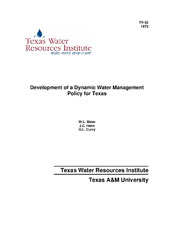| dc.description.abstract | The purpose of this investigation was to develop techniques to assist water planners in the optimum implementation of their plans. Specifically, techniques useful for continual evaluation of water plans and for scheduling the sequence and timing of needed project additions were sought.
Considerable effort has been directed toward developing water plans for meeting long range needs for water both in Texas and around the United States. These long range water plans have consisted of fixed systems of development projects deemed necessary at some future point in time - usually 50 years. Plans such as these are considered flexible guides to serve as water development goals. However, water planners also need implementation plans which specify the sequence and timing of construction for specific projects which are a part of the long range water plan. Previous researchers have studied the application of operations research and optimization techniques in the planning of fixed systems to meet water needs at specific times in the future. This investigation seeks the development of optimization techniques which can be used by planners and developing implementation plans.
In this research, techniques were studied to determine those which best met the research objectives. A stochastic programming formulation for obtaining an operating policy for single, multi-purpose reservoirs based on the continuity equation, stochastic inflow and demand, and chance constraints was developed. The chance constraints were converted to an equivalent linear programming problem. This formulation was then extended to a linked system of multi-purpose reservoirs. Both linear and quadratic objective functions were used with the equivalent linear constraint set.
The problem facing water resource planners during implementation of water plans was then addressed. The objective used in this problem was to select reservoir storage capacities, schedule a time for construction, and establish an operating policy such that the total cost of the linked reservoir system is minimized. In solving this problem which is in fact a mixed integer-continuous linear programming problem, an analyst defines the feasible reservoir segments in storage capacity for each time period in which expansion is possible. The resulting problem size and general structure lend themselves well to the use of a specialized decomposition technique. Use of this decomposition technique permits the problem to be separated into a linear programming problem and an integer programming problem. This approach makes the problem more computationally tractable. | en |


